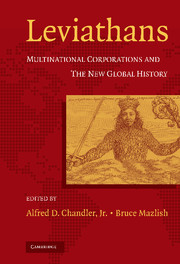Book contents
- Frontmatter
- Contents
- List of Figures and Tables
- Acknowledgments
- List of Contributors
- Introduction
- PART ONE THE SCOPE OF THE MULTINATIONAL PHENOMENON
- 1 A Primer on Multinational Corporations
- 2 Multinational Enterprise to 1930: Discontinuities and Continuities
- 3 Multinationals from the 1930s to the 1980s
- 4 Innovative Multinational Forms: Japan as a Case Study
- PART TWO CULTURAL AND SOCIAL IMPLICATIONS OF MULTINATIONALS
- PART THREE THE GOVERNANCE OF MULTINATIONALS
- Conclusion
- Index
3 - Multinationals from the 1930s to the 1980s
Published online by Cambridge University Press: 17 August 2009
- Frontmatter
- Contents
- List of Figures and Tables
- Acknowledgments
- List of Contributors
- Introduction
- PART ONE THE SCOPE OF THE MULTINATIONAL PHENOMENON
- 1 A Primer on Multinational Corporations
- 2 Multinational Enterprise to 1930: Discontinuities and Continuities
- 3 Multinationals from the 1930s to the 1980s
- 4 Innovative Multinational Forms: Japan as a Case Study
- PART TWO CULTURAL AND SOCIAL IMPLICATIONS OF MULTINATIONALS
- PART THREE THE GOVERNANCE OF MULTINATIONALS
- Conclusion
- Index
Summary
MULTINATIONAL ENTERPRISES AND THE DISINTEGRATION OF A GLOBAL ECONOMY
At the end of the 1920s international business was extensive and widely spread around the world. It had grown rapidly for the previous half century in response to capital mobility and trade protectionism, demand for raw materials and foodstuffs generated by the second industrial revolution, the spread of colonialism, widespread acceptance of international property laws that reduced the risks of financial direct investment (FDI), and improvements in transport and communications. Many multinational enterprises (MNEs) were widely spread. Among them were Ford and General Motors, Nestlé and Unilever, and Shell and Standard Oil of New Jersey, but thousands of small and medium-sized firms had also invested abroad – sometimes in clusters or networks with other firms.
John Dunning has suggested that world FDI had reached around one-third of total world foreign investment, or $14,582 million, by 1914, equivalent to around 9 percent of world output. Despite the disruption of the war, FDI grew further in the 1920s; it had reached $26,350 million by 1938. At the end of the 1920s, most of the stock of world FDI originated from a handful of Western European economies, especially the United Kingdom, accounting for around 40 percent of it. The United States accounted for no more than 25 percent of world FDI, though it had probably replaced the United Kingdom in flows during the 1920s. Latin America and Asia probably accounted for more than 50 percent of FDI stock.
- Type
- Chapter
- Information
- LeviathansMultinational Corporations and the New Global History, pp. 81 - 104Publisher: Cambridge University PressPrint publication year: 2005
- 8
- Cited by



